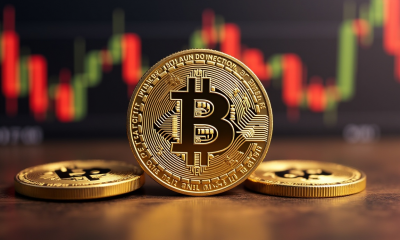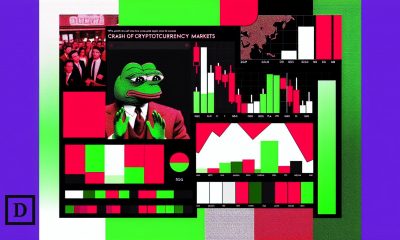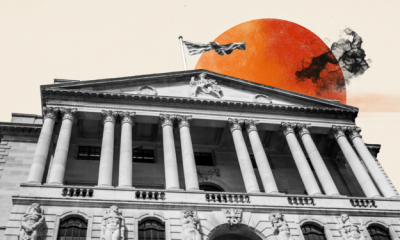

others
EUR/USD recuperates losses during Wednesday’s US session – Crypto News
- EUR/USD recuperates after the losses suffered following Tuesday’s US inflation report.
- The short-term uptrend is now in doubt but the move down lacks momentum.
- Analysts at TD Securities are still penciling in June for a Fed rate cut.
EUR/USD catches a bid during the early US session on Wednesday after seeing some weakness following the release of higher-than-expected inflation data from the United States (US) on Tuesday. The hot inflation data reduced the chances of an early interest-rate cut from the Federal Reserve (Fed).
The pair is trading in the 1.0940s during the US session, down from the last major peak in the 1.0980s reached on Friday.
Investors have shifted their expectations away from the possibility of the Fed pressing the button on cutting interest rates in May, with the focus now more firmly on June.
Since keeping interest rates higher for longer is positive for the US Dollar (USD), as it attracts greater capital inflows, the US Consumer Price Index (CPI) data release has seen the Greenback gain in most pairs, including EUR/USD.
EUR/USD unphased after Eurozone Industrial Production plunges
Eurozone Industrial Production showed a deeper-than-expected decline of 3.2% month-on-month in January, from the downwardly revised 1.6% fall in December, and the expected negative 1.5%, according to data from Eurostat, released on Wednesday.
“It was the sharpest contraction in activity since March of the previous year, and the second-largest decline since the aftermath of the COVID-19 outbreak in April 2020, primarily driven by a staggering 14.5% drop in the production of capital goods.” According to Tradingeconomics.com.
EUR/USD has not reacted much to the release, continuing to trade in the 1.0920s after the data.
EUR/USD: June still on for first rate cut, TD Securities says
June has firmed as the month for liftoff for economists at TD Securities, despite Tuesday’s hot inflation data, as the economists see services inflation continuing to “normalize”, according to a recent note.
“We don’t think today’s report meaningfully changes the Fed’s inclination to first ease by the June FOMC meeting,” they said after the February CPI release.
“In our view, services inflation should resume a clear path toward normalization over the next few months as the tougher seasonal part of the year is already behind us ,” they added.
Ultimately they see the US Dollar weakening in Q2 and Q3, which is likely to provide a positive push for EUR/USD unless the Euro (EUR) suffers equally.
Technical Analysis: EUR/USD continues correction lower
EUR/USD registered another step lower on Tuesday after falling from the 1.0981 peak established on March 8.
The latest decline extends a sequence of falling peaks and troughs and brings into doubt the previous short-term uptrend.
Euro vs US Dollar: 4-hour chart
That said, the move down lacks momentum and has been slower than the move up that preceded it, suggesting there is still a chance it could just be a correction rather than a reversal of the previous uptrend.
It is still possible the correction could fall even lower. One possible zone where price could find support is between 1.0898 (February 2 high) and the top of the Measured Move’s A wave at 1.0888.
A break below 1.0867 would probably solidify the case for a trend reversal and see bears take control.
Resumption of uptrend
A break above 1.0955 would be required for evidence of a resumption of the uptrend. A move above the 1.0981 high of March 8 would provide confirmation as it would establish a higher high.
After that, tough resistance is expected at the 1.1000 psychological level, which is likely to be the scene of a fierce battle between bulls and bears.
A decisive break above 1.1000, however, would open the gates to further gains towards the key resistance level at 1.1139, the December 2023 high.
By “decisive” it is meant a break characterized by a long green candle piercing clearly above the level and closing near its high, or three green bars in a row, breaching the level.
Euro FAQs
The Euro is the currency for the 20 European Union countries that belong to the Eurozone. It is the second most heavily traded currency in the world behind the US Dollar. In 2022, it accounted for 31% of all foreign exchange transactions, with an average daily turnover of over $2.2 trillion a day.
EUR/USD is the most heavily traded currency pair in the world, accounting for an estimated 30% off all transactions, followed by EUR/JPY (4%), EUR/GBP (3%) and EUR/AUD (2%).
The European Central Bank (ECB) in Frankfurt, Germany, is the reserve bank for the Eurozone. The ECB sets interest rates and manages monetary policy.
The ECB’s primary mandate is to maintain price stability, which means either controlling inflation or stimulating growth. Its primary tool is the raising or lowering of interest rates. Relatively high interest rates – or the expectation of higher rates – will usually benefit the Euro and vice versa.
The ECB Governing Council makes monetary policy decisions at meetings held eight times a year. Decisions are made by heads of the Eurozone national banks and six permanent members, including the President of the ECB, Christine Lagarde.
Eurozone inflation data, measured by the Harmonized Index of Consumer Prices (HICP), is an important econometric for the Euro. If inflation rises more than expected, especially if above the ECB’s 2% target, it obliges the ECB to raise interest rates to bring it back under control.
Relatively high interest rates compared to its counterparts will usually benefit the Euro, as it makes the region more attractive as a place for global investors to park their money.
Data releases gauge the health of the economy and can impact on the Euro. Indicators such as GDP, Manufacturing and Services PMIs, employment, and consumer sentiment surveys can all influence the direction of the single currency.
A strong economy is good for the Euro. Not only does it attract more foreign investment but it may encourage the ECB to put up interest rates, which will directly strengthen the Euro. Otherwise, if economic data is weak, the Euro is likely to fall.
Economic data for the four largest economies in the euro area (Germany, France, Italy and Spain) are especially significant, as they account for 75% of the Eurozone’s economy.
Another significant data release for the Euro is the Trade Balance. This indicator measures the difference between what a country earns from its exports and what it spends on imports over a given period.
If a country produces highly sought after exports then its currency will gain in value purely from the extra demand created from foreign buyers seeking to purchase these goods. Therefore, a positive net Trade Balance strengthens a currency and vice versa for a negative balance.
-

 Metaverse1 week ago
Metaverse1 week agoWhat Satya Nadella’s latest shakeup says about Microsoft’s evolving AI strategy – Crypto News
-

 Metaverse1 week ago
Metaverse1 week agoWhat Satya Nadella’s latest shakeup says about Microsoft’s evolving AI strategy – Crypto News
-

 Technology1 week ago
Technology1 week agoAI isn’t the dot-com bubble, but that won’t stop it from ending badly – Crypto News
-
Business1 week ago
Zcash (ZEC) Extends Rally Above $200 as Privacy Narrative Gains Reflexive Momentum – Crypto News
-
Business1 week ago
Breaking: Grayscale Solana ETF (GSOL) to Trade with 0.35% Fee – Crypto News
-

 Blockchain1 week ago
Blockchain1 week agoXRP Price Under Fire – Extended Decline Raises Fears Of Another Major Sell-Off – Crypto News
-

 Technology1 week ago
Technology1 week agoChatGPT will soon pay for you! India’s AI payment pilot set to go live: What it means for users – Crypto News
-

 others6 days ago
others6 days agoChina’s Commerce Ministry urges US to correct its wrong practices as soon as possible – Crypto News
-

 Blockchain1 week ago
Blockchain1 week agoBitcoin Needs Only A Minor Push To Reach $175K: Analyst – Crypto News
-
Business1 week ago
Senate Democrats’ New DeFi Regulation Proposal Stalls Crypto Market Structure Talks – Crypto News
-

 Blockchain1 week ago
Blockchain1 week agoCrypto Entry-Level Jobs Are Scarce: Dragonfly Capital – Crypto News
-

 Metaverse1 week ago
Metaverse1 week agoBubble or not, the AI spending binge is unprecedented in every way – Crypto News
-

 Technology6 days ago
Technology6 days agoBest phones under ₹15,000: Oppo K13 5G, Infinix Note 50s, iQOO Z10x and more – Crypto News
-

 Cryptocurrency4 days ago
Cryptocurrency4 days agoStripe’s stablecoin biz seeks national bank trust charter – Crypto News
-

 Technology1 week ago
Technology1 week agoMeta AI on Instagram can now dub your reels in Hindi: here’s how the feature works – Crypto News
-
Business1 week ago
ASTER Airdrop Delayed to October 20 Amid Criticisms Over Token Allocations – Crypto News
-
Technology1 week ago
STON.fi CMO on Building TON’s Largest Swap & Liquidity Aggregator – Crypto News
-
Technology1 week ago
Tom Lee’s Fundstrat Predicts Ethereum Rally to $5,500 Following ETH ‘Bottom’ – Crypto News
-

 Cryptocurrency1 week ago
Cryptocurrency1 week agoThe Latest Nobel Peace Prize Winner Is a Bitcoin Supporter – Crypto News
-

 others1 week ago
others1 week agoEUR/JPY retreats as Euro slides on French political uncertainty – Crypto News
-
Business1 week ago
Bank of America, Citigroup and Goldman Sachs Explore Issuing Stablecoins Pegged to G7 Currencies – Crypto News
-

 Technology1 week ago
Technology1 week agoBose Angers Customers by Ending Cloud Streaming for Old Speakers – Crypto News
-

 Technology1 week ago
Technology1 week agoBose Angers Customers by Ending Cloud Streaming for Old Speakers – Crypto News
-

 Cryptocurrency1 week ago
Cryptocurrency1 week agoCrypto liquidations drive historic market turbulence – Crypto News
-
others1 week ago
Peter Brandt Flips Bullish on Bitcoin, Ethereum, XRP, and XLM – Crypto News
-

 others1 week ago
others1 week agoA balanced approach to monetary policy only works if inflation expectations are anchored – Crypto News
-

 Cryptocurrency1 week ago
Cryptocurrency1 week agoWhy Bitcoin could rebound up to 21% this week: experts explain – Crypto News
-

 Metaverse1 week ago
Metaverse1 week agohuman intelligence for artificial minds – Crypto News
-

 Metaverse5 days ago
Metaverse5 days agoWalmart teams with OpenAI for ChatGPT purchases. The retailer is ‘ahead of the curve’. – Crypto News
-
others1 week ago
Breaking: $8 Trillion Morgan Stanley Opens Bitcoin Investments to All Wealth Clients – Crypto News
-

 De-fi1 week ago
De-fi1 week agoLarva Labs Art Blocks Auction Surpasses $30,000 – Crypto News
-
others1 week ago
U.S. Inflation Data: BLS to Release CPI Report on October 24 Amid Government Shutdown – Crypto News
-
Business1 week ago
Crypto Market Loses $670 Billion on CEX Auto Liquidations, Altcoins Crash Intensifies – Crypto News
-

 Metaverse1 week ago
Metaverse1 week agoIndia key to shaping future of Artificial Intelligence, says Anthropic CEO Dario Amodei after meeting PM Modi – Crypto News
-

 Blockchain1 week ago
Blockchain1 week agoCrypto Traders Show ‘Rationalization’ Behavior’ After Market Plunge – Crypto News
-

 Blockchain1 week ago
Blockchain1 week agoHow to Use ChatGPT to Discover Hidden Crypto Gems – Crypto News
-

 others5 days ago
others5 days agoSeems ‘prudent’ to cut rates further given lower inflation risks – Crypto News
-
others1 week ago
Pump.fun Rival Zora Rallies Over 30% Following Robinhood Listing – Crypto News
-

 Cryptocurrency1 week ago
Cryptocurrency1 week agoMorgan Stanley opens crypto fund access to all wealth clients – Crypto News
-

 Technology1 week ago
Technology1 week agoPENGU turns bullish as Pudgy Penguins teams up with Nasdaq-listed Sharps Technology – Crypto News
-

 Cryptocurrency1 week ago
Cryptocurrency1 week agoPolymarket Token Is Coming, But Likely Not This Year: Sources – Crypto News
-

 De-fi1 week ago
De-fi1 week agoCrypto Markets Plummet as BTC Briefly Drops Below $106K – Crypto News
-
Business1 week ago
Here’s Why XRP Price May Have a Zcash-Like Surge – Crypto News
-

 Metaverse1 week ago
Metaverse1 week agoClaude automates reports and presentations effortlessly – Crypto News
-
Business1 week ago
Is the Bitcoin Top In? Raoul Pal Signals Higher Liquidity Cycle Despite Market Selloff – Crypto News
-

 Cryptocurrency1 week ago
Cryptocurrency1 week agoShiba Inu Burn Rate Crashes 99% as Crypto Sees Largest Liquidation Event Ever – Crypto News
-

 Cryptocurrency1 week ago
Cryptocurrency1 week agoDecoding WLFI’s meltdown – Can a $7mln buyback undo a $190mln dump? – Crypto News
-

 others1 week ago
others1 week agoTrump’s tariff threat pushes US Dollar below 99 amid trade tensions – Crypto News
-

 Cryptocurrency7 days ago
Cryptocurrency7 days agoHow Solana Overtook Ethereum’s Early Growth Curve – Crypto News
-
Business7 days ago
Crypto Market Recovery: BTC, ETH, XRP, DOGE Surge 4-12% As Expert Sees V-Shape Upside – Crypto News










